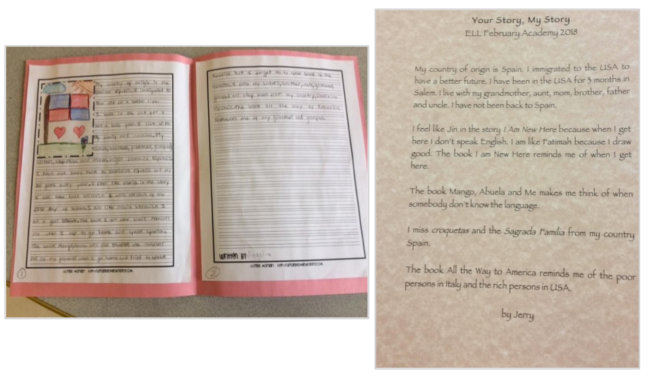Marta tweeted a picture of her 4-day unit about helping ELLs tell their stories. I was so moved and inspired by her unit that I wanted to share it with you. Not only did this unit empower ELLs to share their experience, it also developed students vocabulary, reading, and writing skills that I had to share it.
I hope you’re inspired to create similar units.
In Salem, Ma, we did exactly that! ELL February vacation was entirely devoted to immigrant stories through the theme, Your Story, My Story… ELLs wrote their stories and created bicultural self portraits… pic.twitter.com/IzdwlTCTdY
— Marta (@martagcuasante) February 24, 2018
The ESL department created this 4-day academy under the title Your Story, My Story with the intention of giving voice to our ELL students, who don’t usually have a platform to be vocal about their immigration stories. We wanted to create a space for a “counter-narrative” on immigration given the current national conversation about this topic.
We planned activities across grades because immigrant students share similar stories and the need to have a voice. Also, previous activities involving students across grades have proven to be highly effective and meaningful!
Program Description
The February Vacation Academy for grades 2-5 was primarily a literature-based unit, with a focus on narratives of immigration from a variety of perspectives. Selecting from this variety of texts with an immigration theme, teachers engaged in read-alouds with the students, provided time for both retelling the story, and searched for deeper meanings related to immigration themes: courage, fear, adversity, resilience, adapting, cultural identity, cultural pride, love of language, and so on.
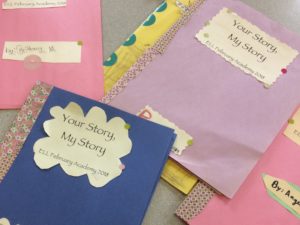 Using the stories as examples, students co-created an interview sheet to use with their families to generate details for their own immigration stories. Each student then wrote and illustrated his or her own family story.
Using the stories as examples, students co-created an interview sheet to use with their families to generate details for their own immigration stories. Each student then wrote and illustrated his or her own family story.
The emphasis on the final project was on both retelling with detail and on explicitly relating to the themes that are pulled from the literature. In addition, students worked on fluent reading of their own stories, for an authentic audience – both the high school students in the same program and for an external audience.
Involving the Entire District
A team of teachers, ESL coach, and ESL director met for two sessions to plan the structure, curriculum, and art projects. Based on the enrollment information, we created one group of 2nd graders, and another group combining 3rd, 4th, and 5th graders. We also had a group of high school newcomers.
ELL students from all schools in Salem, MA, participated in a 4-day program during which they wrote their own immigration stories, listened to books, and shared their stories with their high school “reading buddies.”
Students in the elementary grades spent time with newcomer high school ELLs and participated in activities such us “mix and mingle”, “scavenger hunts”, singing, and read-alouds.
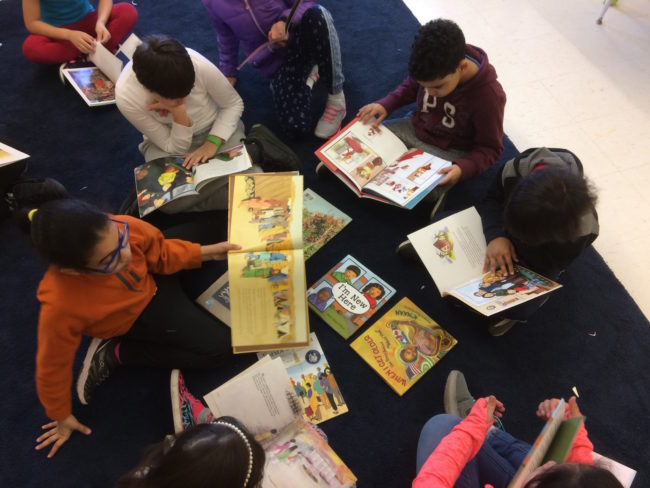
Elementary students created bicultural self-portraits with an art teacher, and high school ELLs created posters featuring current immigration issues, such as DACA. The purpose of this time in common was to build relationships between the two groups. We also wanted the newcomer high schoolers (who have been here in the country for only a few months) to have linguistic models in the younger children (who have been in the US longer in many cases.)
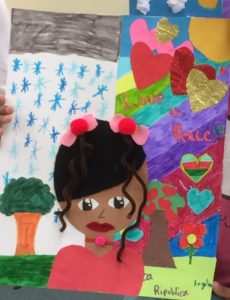
There was a heavily emotional component to the time they spent together, the activities they shared (both planned and spontaneous), and the song we sang together. At the end of the day, students gave shout-outs to their peers: elementary students would always give shout outs to the high schoolers for their patience, humor, and support.
Elementary students also created suitcases which contained their writing pieces, cards with pictures of the things/people/animals they miss from their countries, the lyrics of the song Wavin’ Flag (by K’Naan), which we sang every day and became our hymn.
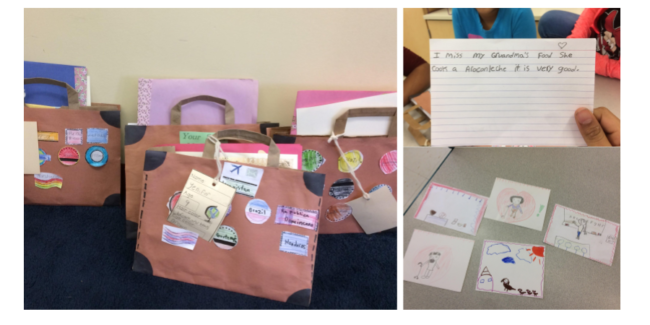
Vocabulary development
As part of the 4-day immigration unit, we developed vocabulary related to the topic. Students needed explicit instruction on vocabulary words that they would be using in their final writing project or words that they would encounter in the read alouds. The following is the vocabulary cards were created for this unit.
A part of the day was devoted to discussing the vocabulary through the use of the vocab cards (projected on the big screen.) Oral language was developed through these discussions where we talked about meaning, uses of the words in context, and cognates. These are the cards used in this process.
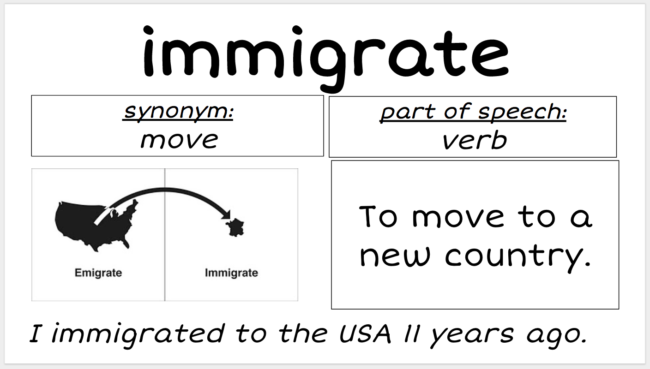
After the oral whole group discussion, students wrote the words and their definitions and illustrated them in a graphic organizer also designed for the occasion. They had hard copies of the vocab cards and worked in groups. A great deal of oral language took place during this group work.
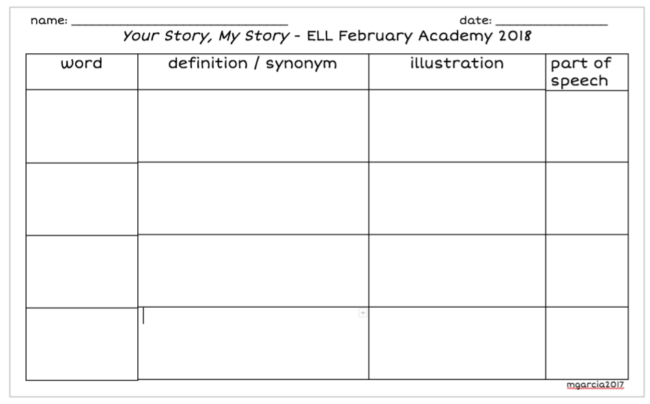
Literacy component
The ESL department purchased a variety of picture books around the theme of immigration to be used as a way to inspire our students to tell their stories and share their feelings. Some of the titles included:
- I’m New Here
by Anne Sibley O’Brien (about 3 newcomer students and how they feel about being in a new school not knowing English, and how their individual strengths help them not only become part of the classroom culture but also be admired by their peers).
- All the Way to America: The Story of a Big Italian Family and a Little Shovel
by Dan Yaccarino (story of an Italian immigrant a few generations ago and how the special things that he brought in his suitcase helped the next generations to be successful in the US.)
- Grandfather’s Journey
by Allen Say (the author’s grandfather’s journey from Japan to the US and back again. The book describes the feelings of love for both countries and a strong desire to be in both places at once)
- Mango, Abuela, and Me
by Meg Medina (about the relationship between a grandmother and her granddaughter and their initial difficulty to understand each other because of their language barriers, and how the initial problem gets resolved by their willingness to communicate.)
- When I Get Older: The Story behind “Wavin’ Flag”
by K’Naan (about the struggle of a family of refugees from Somalia in their immigration experience in the US and Canada, and how the teachings of the grandfather helped the author overcome fear.)
These stories were introduced as interactive read alouds. Students made connections with their lives as the stories unfolded, they identified with the feelings, frustrations, and courage demonstrated by the characters in the stories. They also made connections between the texts. They wrote responses in their journals after listening to each of the stories. Some of these reflections were later incorporated in their final writing projects.
Students wrote reflections after we read the stories, after oral activities such as “turn and talk” . They used sentence starters and frames like these to guide their thinking:
“I feel like ____________________ in the story I Am New Here because_____________________”
“ I am like ____________________ in the story I Am New Here because I can _____________________”
Home communication
In order to include our families in the project we designed an interview for parents to complete at home. The questions were mostly facts about their country of origin, time in the US, a reason to move here, members of the family who still live in the native countries, etc. A letter informing parents of the strictly academic purpose of our questions accompanied the interview in order to alleviate any fear of the purpose of our inquiry.
Developing writing skills
Reflection
This February Academy project was one of the most rewarding teaching experiences of my career. The level of engagement and passion on the part of the students was remarkable because their stories were the focus of the whole program. They spoke in the first person about their journeys, they listened to each other and listened to stories the identified with. They listened to stories they easily identified with: feelings were discussed, and a sense of community was created around a common thread, that of separation, fear, and challenge but also hope, happiness, and accomplishment.
The highlight of the day was always when the newcomer high schoolers came to share their day with us, played games (“mix and mingle” activities turned the room into a vibrant space where students asked questions, learned from each other, and helped…,) went on scavenger hunts, helped make the suitcases, and sang Wavin’ Flag.
This special relationship has been used to plan an ongoing partnership with the high school and our elementary school, by which those same newcomers come to our school every week and share readings, activities, and build relationships.
Marta’s Bio ( @martagcuasante )
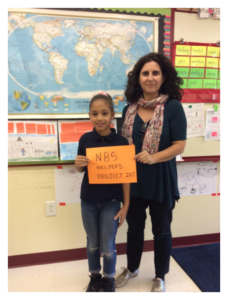
Here with my student Mariana in our classroom.
I am from Spain where I studied majored in English language and literature. I started my career in Los Angeles, as a visiting teacher in the bilingual program in East Los Angeles area for 7 years. Those years taught me most of what I know today about immigration, cultures in contact, the sociolinguistics of bilingual children, etc. I went back to my country where I started a family and completed some graduate work on the topic of feminist discourse and women’s literature, as well as literature written by minorities.
After a few years, my husband, two daughters and I moved to Salem where I have been teaching during 11 years as an ESL teacher in a district increasing populated by immigrants, mostly from the Caribbean. I completed my master’s degree in teaching English as a Second Language at Salem State University. Teaching English to students who speak other languages has become my passion and my commitment. I particularly enjoy the component of social justice and advocacy of my practice.
I work with an amazing group of ESL teachers under a very strong ESL department leadership. I am an immigrant and ELL myself. I am curious by nature, love music, food from all corners of the planet.

